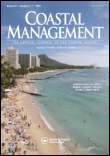Indigenous Community Health and Climate Change: Integrating Biophysical and Social Science Indicators
This paper appears in the July 2014 issue of the journal Coastal Management, which focuses on the role of social sciences in Puget Sound ecosystem recovery.

Extended abstract
Several parallel efforts among U.S. and Canadian Indigenous communities and federal, provincial, state, academic and non-profit organizations are underway to identify and assess species, habitat, and human health and well-being sensitivities to climate change at local and landscape scales. Although these assessments represent crucial steps forward, most assessments related to human health focus on individual, physiological health; no systematic method of evaluating and prioritizing climate driven-
risks and impacts to Indigenous communities based on Indigenous health definitions exists. Many Indigenous peoples define health and well-being similarly, including familial and community-wide considerations, reflecting interlinked social, cultural, spiritual, environmental and psychological aspects of health. How health is defined and assessed is a high priority for Indigenous communities, who are confronted with considerable health risks from impacts to homelands and beyond.
The project described herein cross-walks biophysical and social science by pilot-testing a set of recently developed Indigenous community health indicators (IHIs) to identify coastal climate adaptation priorities in two Coast Salish communities (Washington State, United States and British Columbia, Canada). The indicators’ efficacy is tested by the Swinomish Indian Tribal Community (Washington State) and the Tsleil-Waututh First Nation (British Columbia) by evaluating community health impacts and priorities based on projected climate change effects to shorelines, shellfish habitat, and archaeological resources.
Coastal Indigenous communities are disproportionally affected by climate change and sea-level rise because natural and cultural resources available to these communities are bound geographically to legally defined reserves. For this pilot effort, researchers evaluated existing digital datasets representing shellfish biomass, sediment characteristics, beach elevation, archeological resources, and shoreline armoring to generate cultural shoreline vulnerability maps for both communities. These cultural shoreline vulnerability maps provided a visual tool that generally characterized impacts given current projections of sea-level rise through year 2100. Based on these mapping exercises, it is projected that by year 2100 the Swinomish Indian Tribal Community and Tsleil-Waututh will experience a 27% and 75% reduction in harvestable intertidal shellfish habitat, respectively.
Descriptive scaling techniques, employed in facilitated workshops with the two communities, tested the efficacy of ranking six key indicators of community health (natural resources security, education, community connection, self-determination, cultural use and practices and well-being) in relation to projected impacts to shellfish habitat and shoreline archaeological sites stemming from changes in the biophysical environment. Findings demonstrate that: when shellfish habitat and archaeological resources are impacted, so is Indigenous community health; not all community health indicators are equally impacted; and, the community health indicators of highest concern to the community are not necessarily the same indicators most likely to be impacted by climate change.
Based on the findings and feedback from community participants, the exploratory trials were successful. Indigenous-specific health indicators may be useful to Indigenous communities who are assessing climate change sensitivities and creating adaptation plans. By engaging community members to create and test health indicators that are commensurate with many commonly employed climate change impact assessment and adaptation planning indicators, the preliminary approach described here demonstrates how such assessment and planning efforts can be meaningfully informed in a culturally respectful way for those to whom climate change impacts matter the most—the community themselves. The Swinomish Indian Tribal Community led the work presented here, in collaboration with the Tsleil-Waututh First Nation, and the U.S. Geological Survey’s Pacific Coastal and Marine Science Center and Western Fisheries Research Center.
Citation
Donatuto, J., Grossman, E. E., Konovsky, J., Grossman, S., & Campbell, L. W. (2014). Indigenous Community Health and Climate Change: Integrating Biophysical and Social Science Indicators. Coastal Management, 42(4), 355-373.

